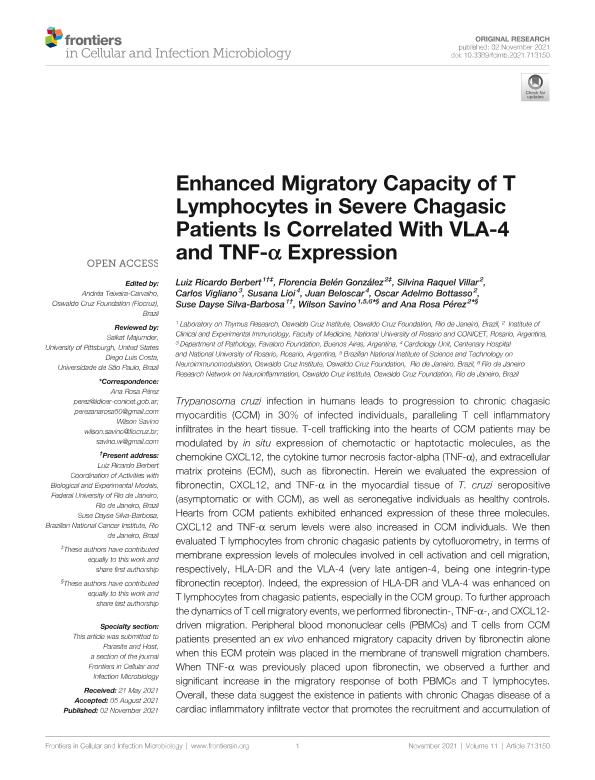Mostrar el registro sencillo del ítem
dc.contributor.author
Berbert, Luiz Ricardo
dc.contributor.author
González, Florencia Belén

dc.contributor.author
Villar, Silvina Raquel

dc.contributor.author
Vigliano, Carlos

dc.contributor.author
Lioi, Susana
dc.contributor.author
Beloscar, Juan
dc.contributor.author
Bottasso, Oscar Adelmo

dc.contributor.author
Silva-Barbosa, Suse Dayse
dc.contributor.author
Savino, Wilson
dc.contributor.author
Perez, Ana Rosa

dc.date.available
2023-01-26T17:10:31Z
dc.date.issued
2021-11
dc.identifier.citation
Berbert, Luiz Ricardo; González, Florencia Belén; Villar, Silvina Raquel; Vigliano, Carlos; Lioi, Susana; et al.; Enhanced Migratory Capacity of T Lymphocytes in Severe Chagasic Patients Is Correlated With VLA-4 and TNF-α Expression; Frontiers Media; Frontiers in Cellular and Infection Microbiology; 11; 11-2021; 1-11
dc.identifier.issn
2235-2988
dc.identifier.uri
http://hdl.handle.net/11336/185801
dc.description.abstract
Trypanosoma cruzi infection in humans leads to progression to chronic chagasic myocarditis (CCM) in 30% of infected individuals, paralleling T cell inflammatory infiltrates in the heart tissue. T-cell trafficking into the hearts of CCM patients may be modulated by in situ expression of chemotactic or haptotactic molecules, as the chemokine CXCL12, the cytokine tumor necrosis factor-alpha (TNF-α), and extracellular matrix proteins (ECM), such as fibronectin. Herein we evaluated the expression of fibronectin, CXCL12, and TNF-α in the myocardial tissue of T. cruzi seropositive (asymptomatic or with CCM), as well as seronegative individuals as healthy controls. Hearts from CCM patients exhibited enhanced expression of these three molecules. CXCL12 and TNF-α serum levels were also increased in CCM individuals. We then evaluated T lymphocytes from chronic chagasic patients by cytofluorometry, in terms of membrane expression levels of molecules involved in cell activation and cell migration, respectively, HLA-DR and the VLA-4 (very late antigen-4, being one integrin-type fibronectin receptor). Indeed, the expression of HLA-DR and VLA-4 was enhanced on T lymphocytes from chagasic patients, especially in the CCM group. To further approach the dynamics of T cell migratory events, we performed fibronectin-, TNF-α-, and CXCL12-driven migration. Peripheral blood mononuclear cells (PBMCs) and T cells from CCM patients presented an ex vivo enhanced migratory capacity driven by fibronectin alone when this ECM protein was placed in the membrane of transwell migration chambers. When TNF-α was previously placed upon fibronectin, we observed a further and significant increase in the migratory response of both PBMCs and T lymphocytes. Overall, these data suggest the existence in patients with chronic Chagas disease of a cardiac inflammatory infiltrate vector that promotes the recruitment and accumulation of activated T cells, driven in part by enhanced tissue expression of fibronectin and TNF-α, as well as the respective corresponding VLA-4 and TNF receptors.
dc.format
application/pdf
dc.language.iso
eng
dc.publisher
Frontiers Media

dc.rights
info:eu-repo/semantics/openAccess
dc.rights.uri
https://creativecommons.org/licenses/by-nc-sa/2.5/ar/
dc.subject
CHEMOKINES
dc.subject
CHRONIC CHAGASIC MYOCARDITIS
dc.subject
CORTISOL
dc.subject
LYMPHOCYTE MIGRATION
dc.subject
VLA-4
dc.subject.classification
Inmunología

dc.subject.classification
Medicina Básica

dc.subject.classification
CIENCIAS MÉDICAS Y DE LA SALUD

dc.title
Enhanced Migratory Capacity of T Lymphocytes in Severe Chagasic Patients Is Correlated With VLA-4 and TNF-α Expression
dc.type
info:eu-repo/semantics/article
dc.type
info:ar-repo/semantics/artículo
dc.type
info:eu-repo/semantics/publishedVersion
dc.date.updated
2022-10-06T10:41:59Z
dc.journal.volume
11
dc.journal.pagination
1-11
dc.journal.pais
Estados Unidos

dc.journal.ciudad
Louisville
dc.description.fil
Fil: Berbert, Luiz Ricardo. Fundación Oswaldo Cruz; Brasil. Universidade Federal do Rio de Janeiro; Brasil
dc.description.fil
Fil: González, Florencia Belén. Consejo Nacional de Investigaciones Científicas y Técnicas. Centro Científico Tecnológico Conicet - Rosario. Instituto de Inmunología Clinica y Experimental de Rosario. Universidad Nacional de Rosario. Facultad de Ciencias Médicas. Instituto de Inmunología Clinica y Experimental de Rosario; Argentina
dc.description.fil
Fil: Villar, Silvina Raquel. Consejo Nacional de Investigaciones Científicas y Técnicas. Centro Científico Tecnológico Conicet - Rosario. Instituto de Inmunología Clinica y Experimental de Rosario. Universidad Nacional de Rosario. Facultad de Ciencias Médicas. Instituto de Inmunología Clinica y Experimental de Rosario; Argentina
dc.description.fil
Fil: Vigliano, Carlos. Universidad Favaloro. Facultad de Medicina; Argentina. Consejo Nacional de Investigaciones Científicas y Técnicas; Argentina
dc.description.fil
Fil: Lioi, Susana. Universidad Nacional de Rosario; Argentina
dc.description.fil
Fil: Beloscar, Juan. Hospital Provincial del Centenario; Argentina
dc.description.fil
Fil: Bottasso, Oscar Adelmo. Consejo Nacional de Investigaciones Científicas y Técnicas. Centro Científico Tecnológico Conicet - Rosario. Instituto de Inmunología Clinica y Experimental de Rosario. Universidad Nacional de Rosario. Facultad de Ciencias Médicas. Instituto de Inmunología Clinica y Experimental de Rosario; Argentina
dc.description.fil
Fil: Silva-Barbosa, Suse Dayse. Fundación Oswaldo Cruz; Brasil
dc.description.fil
Fil: Savino, Wilson. Fundación Oswaldo Cruz; Brasil
dc.description.fil
Fil: Perez, Ana Rosa. Consejo Nacional de Investigaciones Científicas y Técnicas. Centro Científico Tecnológico Conicet - Rosario. Instituto de Inmunología Clinica y Experimental de Rosario. Universidad Nacional de Rosario. Facultad de Ciencias Médicas. Instituto de Inmunología Clinica y Experimental de Rosario; Argentina
dc.journal.title
Frontiers in Cellular and Infection Microbiology
dc.relation.alternativeid
info:eu-repo/semantics/altIdentifier/doi/http://dx.doi.org/10.3389/fcimb.2021.713150
Archivos asociados
